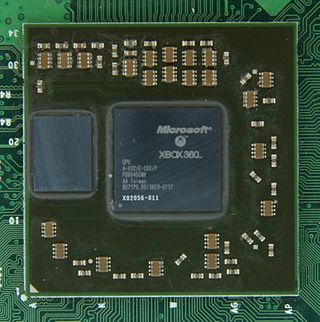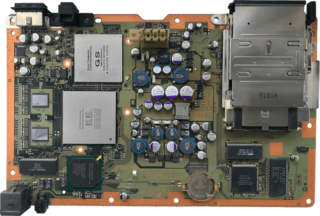
Synchronous dynamic random-access memory is any DRAM where the operation of its external pin interface is coordinated by an externally supplied clock signal.
Rambus DRAM (RDRAM), and its successors Concurrent Rambus DRAM (CRDRAM) and Direct Rambus DRAM (DRDRAM), are types of synchronous dynamic random-access memory (SDRAM) developed by Rambus from the 1990s through to the early 2000s. The third-generation of Rambus DRAM, DRDRAM was replaced by XDR DRAM. Rambus DRAM was developed for high-bandwidth applications and was positioned by Rambus as replacement for various types of contemporary memories, such as SDRAM. RDRAM is a serial memory bus.

The Cray Y-MP was a supercomputer sold by Cray Research from 1988, and the successor to the company's X-MP. The Y-MP retained software compatibility with the X-MP, but extended the address registers from 24 to 32 bits. High-density VLSI ECL technology was used and a new liquid-cooling system was devised. The Y-MP ran the Cray UNICOS operating system.

The Emotion Engine is a central processing unit developed and manufactured by Sony Computer Entertainment and Toshiba for use in the PlayStation 2 video game console. It was also used in early PlayStation 3 models sold in Japan and North America to provide PlayStation 2 game support. Mass production of the Emotion Engine began in 1999 and ended in late 2012 with the discontinuation of the PlayStation 2.

The GeForce 7 series is the seventh generation of Nvidia's GeForce line of graphics processing units. This was the last series available on AGP cards.

The Cray T3E was Cray Research's second-generation massively parallel supercomputer architecture, launched in late November 1995. The first T3E was installed at the Pittsburgh Supercomputing Center in 1996. Like the previous Cray T3D, it was a fully distributed memory machine using a 3D torus topology interconnection network. The T3E initially used the DEC Alpha 21164 (EV5) microprocessor and was designed to scale from 8 to 2,176 Processing Elements (PEs). Each PE had between 64 MB and 2 GB of DRAM and a 6-way interconnect router with a payload bandwidth of 480 MB/s in each direction. Unlike many other MPP systems, including the T3D, the T3E was fully self-hosted and ran the UNICOS/mk distributed operating system with a GigaRing I/O subsystem integrated into the torus for network, disk and tape I/O.

The Xenos is a custom graphics processing unit (GPU) designed by ATI, used in the Xbox 360 video game console developed and produced for Microsoft. Developed under the codename "C1", it is in many ways related to the R520 architecture and therefore very similar to an ATI Radeon X1800 XT series of PC graphics cards as far as features and performance are concerned. However, the Xenos introduced new design ideas that were later adopted in the TeraScale microarchitecture, such as the unified shader architecture. The package contains two separate dies, the GPU and an eDRAM, featuring a total of 337 million transistors.

The RSX 'Reality Synthesizer' is a proprietary graphics processing unit (GPU) codeveloped by Nvidia and Sony for the PlayStation 3 game console. It is based on the Nvidia 7800GTX graphics processor and, according to Nvidia, is a G70/G71 hybrid architecture with some modifications. The RSX has separate vertex and pixel shader pipelines. The GPU makes use of 256 MB GDDR3 RAM clocked at 650 MHz with an effective transmission rate of 1.3 GHz and up to 224 MB of the 3.2 GHz XDR main memory via the CPU . Although it carries the majority of the graphics processing, the Cell Broadband Engine, the console's CPU, is also used complementarily for some graphics-related computational loads of the console.
Glaze3D was a family of graphics cards announced by BitBoys Oy on August 2, 1999, that would have produced substantially better performance than other consumer products available at the time. The family, which would have come in the Glaze3D 1200, Glaze3D 2400 and Glaze3D 4800 models, was supposed to offer full support for DirectX 7, OpenGL 1.2, AGP 4×, 4× anisotropic filtering, full-screen anti-aliasing and a host of other technologies not commonly seen at the time. The 1.5 million gate GPU would have been fabricated by Infineon on a 0.2 μm eDRAM process, later to be reduced to 0.17 μm with a minimum of 9 MB of embedded DRAM and 128 to 512 MB of external SDRAM. The maximum supported video resolution was 2048×1536 pixels.

Graphics Double Data Rate 5 Synchronous Dynamic Random-Access Memory is a type of synchronous graphics random-access memory (SGRAM) with a high bandwidth interface designed for use in graphics cards, game consoles, and high-performance computing. It is a type of GDDR SDRAM.
The Namco System 246 is a development of the Sony PlayStation 2 technology as a basis for an arcade system board. It was released in December 2000 on its first game Bloody Roar 3. Like the Sega NAOMI, it is widely licensed for use by other manufacturers. Games such as Battle Gear 3 and Capcom Fighting Evolution are examples of System 246-based arcade games that are not Namco products.
The GeForce 9 series is the ninth generation of Nvidia's GeForce line of graphics processing units, the first of which was released on February 21, 2008. The products are based on an updated Tesla microarchitecture, adding PCI Express 2.0 support, improved color and z-compression, and built on a 65 nm process, later using 55 nm process to reduce power consumption and die size.
The Xbox 360 technical specifications describe the various components of the Xbox 360 video game console.

The PlayStation 3 technical specifications describe the various components of the PlayStation 3 (PS3) video game console.

Gekko is a superscalar out-of-order 32-bit PowerPC microprocessor custom-made by IBM in 2000 for Nintendo to use as the CPU in their sixth generation game console, the GameCube, and later the Triforce Arcade Board.
The ZEGO is a rackmount server platform built by Sony, targeted for the video post-production and broadcast markets. The platform is based on Sony's PlayStation 3 as it features both the Cell Processor as well as the RSX 'Reality Synthesizer'. It is aimed to greatly speed up postproduction work, 3D rendering and video processing. In some respects it is rather similar to IBM's QS20/21/22 blades, although Sony seems to target the DCC markets rather than scientific like IBM, which can be seen by the inclusion of the RSX graphics processor in the ZEGO platform.
The PlayStation 4 technical specifications describe the various hardware components of the PlayStation 4 home video game console group. Multiple versions of this console have been released since the initial launch of the PlayStation 4, including the PlayStation 4 Slim and the PlayStation 4 Pro. Subsequent versions include changes to the technical specifications of the console.

The PlayStation 2 technical specifications describe the various components of the PlayStation 2 (PS2) video game console.

The Xbox technical specifications describe the various components of the Xbox video game console.

The PlayStation technical specifications describe the various components of the original PlayStation video game console.












